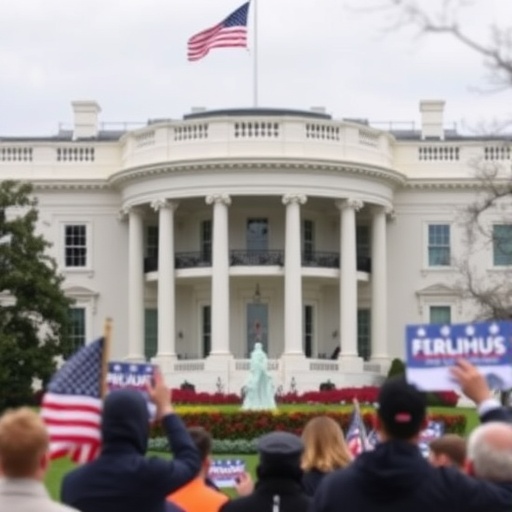Senate Republicans Rally at White House as Government shutdown Enters Fourth Week, Leaving Federal Workers in Limbo
In a bold display of party unity, Senate Republicans gathered at the White House on Wednesday to confer with President Donald Trump, as the ongoing Government shutdown stretches into its fourth week, paralyzing federal operations and affecting over 800,000 federal workers. The meeting, shrouded in the tension of political deadlock, underscores the deepening divide between Democrats and Republicans over funding for border security, with no immediate resolution in sight. As essential services teeter on the brink, the human cost of the impasse becomes increasingly stark, with families facing unpaid bills and critical programs like health care subsidies at risk of disruption.
- Senate Republicans’ White House Summit Signals Unwavering Support for Trump’s Agenda
- Federal Workers Bear the Brunt: Unpaid Salaries and Mounting Hardships
- Border Wall Standoff Clashes with Democratic Priorities on Health Care Subsidies
- Critical Federal Programs Teeter on the Edge of Collapse
- Path Forward: Bipartisan Breakthroughs and Looming Deadlines
Senate Republicans’ White House Summit Signals Unwavering Support for Trump’s Agenda
The Senate Republicans arrived at the White House in a convoy of black SUVs, their faces set with determination amid the winter chill in Washington, D.C. Led by Senate Majority Leader Mitch McConnell, the group of approximately 30 GOP senators convened in the Oval Office for a closed-door session with President Trump. Sources close to the meeting described it as a “rallying cry” for Republican cohesion, aimed at countering what they perceive as Democratic obstructionism on immigration reform.
“We’re here to stand shoulder-to-shoulder with the President,” McConnell told reporters outside the White House gates before entering. “This Government shutdown isn’t about politics; it’s about securing our borders and fulfilling promises to the American people.” The session lasted over two hours, focusing on strategy for upcoming votes in Congress. Trump, flanked by his top advisors, reportedly emphasized the need for $5.7 billion in funding for a border wall, a cornerstone of his 2016 campaign that has now become the epicenter of the fiscal standoff.
Attendees included high-profile figures like Senators Lindsey Graham of South Carolina and Ted Cruz of Texas, both vocal advocates for stricter immigration policies. Graham, emerging from the meeting, stated, “Democrats are playing games with national security. We’re united in pushing back.” This gathering marks the latest in a series of Republican maneuvers to project strength during the shutdown, which began on December 22 after Congress failed to pass a spending bill by year’s end.
Behind the scenes, the White House has been buzzing with activity. Staffers leaked details of internal polling showing Republican base support holding firm at 85% for the wall funding, even as national approval for the shutdown dips below 40%. The summit wasn’t just symbolic; it involved hashing out potential concessions, such as temporary funding extensions tied to border security measures, though no breakthroughs were announced.
Federal Workers Bear the Brunt: Unpaid Salaries and Mounting Hardships
As politicians huddle in heated rooms, the reality for federal workers paints a far grimmer picture. More than 800,000 civilian employees across agencies like the Department of Homeland Security, the IRS, and national parks have been furloughed or working without pay since the government shutdown commenced. For many, this marks the longest shutdown in U.S. history, surpassing the 21-day record set in 1995-1996.
Take Sarah Jenkins, a 42-year-old TSA officer at Reagan National Airport. “I’ve been screening passengers every day, but my family’s Christmas was ruined,” Jenkins shared in an interview with our news team. “We’re dipping into savings for groceries, and I don’t know when the next paycheck comes.” Her story echoes thousands: federal workers, from air traffic controllers to Smithsonian curators, are resorting to food banks, credit card debt, and side gigs to make ends meet.
Statistics underscore the crisis. The Partnership for Public Service estimates that the shutdown has already cost the economy $11 billion, with indirect losses from reduced consumer spending pushing that figure higher. In the Washington, D.C., area alone, 40,000 federal employees are affected, leading to a 15% drop in local retail sales. Essential workers, numbering around 420,000, continue their duties—coasting guards patrolling waters, FBI agents pursuing leads—but without compensation, morale is plummeting.
One poignant example comes from the National Institutes of Health (NIH), where research on cancer and infectious diseases has halted. Dr. Elena Vasquez, a researcher, lamented, “We’re losing irreplaceable data and patient progress. This isn’t just about pay; it’s about lives on hold.” The shutdown’s ripple effects extend to contractors and vendors, amplifying the financial strain on communities nationwide.
- Key Impacts on Federal Workers:
- Unpaid for up to 28 days, with backpay promised but uncertain.
- Access to federal credit unions strained, with loan applications up 300%.
- Mental health hotline calls from government employees have surged 50%.
Community support has emerged as a silver lining. Nonprofits like the Capital Area Food Bank report a 25% increase in demand, while crowdfunding campaigns for affected workers have raised over $2 million. Yet, as the shutdown persists, experts warn of long-term consequences, including talent exodus from public service.
Border Wall Standoff Clashes with Democratic Priorities on Health Care Subsidies
At the heart of the government shutdown lies an intractable dispute: Republicans’ insistence on border wall funding versus Democrats’ demands for comprehensive immigration reform without what they call a “medieval vanity project.” President Trump’s $5.7 billion request has been met with counteroffers from House Democrats, who control the chamber, proposing $1.3 billion for border technology instead.
The Senate Republicans, fresh from their White House powwow, doubled down on their position. “No wall, no deal,” Cruz declared post-meeting, echoing Trump’s rhetoric that the structure is essential for curbing illegal immigration and drug trafficking. Data from U.S. Customs and Border Protection shows a 20% rise in migrant encounters at the southern border in fiscal year 2018, fueling GOP arguments.
Democrats, led by Speaker Nancy Pelosi, counter that resources should address root causes like asylum processing backlogs. “This shutdown is hurting real people for a political stunt,” Pelosi said in a floor speech. The impasse has broader implications, particularly for health care subsidies. The shutdown endangers the renewal of the Children’s Health Insurance Program (CHIP), which provides coverage to 9 million low-income children and relies on federal funding set to expire soon.
Additionally, Affordable Care Act (health care subsidies) for marketplace enrollees could face delays in reimbursements, potentially increasing premiums by 10-15% if unresolved. The Congressional Budget Office projects that prolonged disruption might leave 2 million uninsured. “We’re talking about families who can’t afford doctor’s visits,” warned Sen. Chuck Schumer, D-N.Y., highlighting how the border fight is collateral damage to public health.
Negotiations have stalled in the Senate, where a clean continuing resolution failed last week on a party-line vote. Republicans hold a slim majority but need Democratic votes to overcome filibusters, creating a vicious cycle. Bipartisan talks, mediated by Vice President Mike Pence, have yielded little, with trust eroded after multiple false starts.
- Timeline of Key Events:
- Dec. 22: Shutdown begins after funding bill rejection.
- Jan. 10: Trump addresses nation, demanding wall funds.
- Jan. 15: Senate Republicans’ White House rally.
- Upcoming: Potential House vote on compromise package.
Immigration experts like Doris Meissner from the Migration Policy Institute note, “This isn’t just about walls; it’s a proxy for deeper policy divides.” As temperatures drop—both literal and figurative—the pressure mounts for a thaw.
Critical Federal Programs Teeter on the Edge of Collapse
Beyond the immediate payroll woes, the government shutdown threatens a cascade of vital services. National parks, closed to visitors, have seen vandalism and lost revenue topping $100 million. The IRS, operating on skeleton staff, delays tax refunds for millions, with processing times extended by weeks.
In the realm of health care subsidies, the Centers for Medicare & Medicaid Services (CMS) warns of payment disruptions. Over 12 million Americans receive premium tax credits through the ACA, and a funding lapse could force insurers to hike rates or drop plans. CHIP’s fate is particularly dire; 37 states have reserve funds, but nine, including Texas and Florida, face immediate shortfalls affecting 1.5 million children.
Environmental protections are another casualty. The Environmental Protection Agency (EPA) has halted enforcement actions, allowing potential polluters to operate unchecked. “We’re seeing illegal dumping rise by 30% in monitored areas,” said an anonymous EPA official. Food safety inspections by the FDA have slowed, raising concerns about imported goods amid flu season peaks.
The Small Business Administration (SBA) loan program, crucial for entrepreneurs, is frozen, stalling $1.5 billion in approvals. Veterans’ benefits, while partially funded, face delays in claims processing, frustrating the 18 million who rely on the VA. “My disability claim is in limbo,” shared Army veteran Mark Thompson. “This shutdown is a betrayal of those who served.”
Internationally, U.S. passport processing has backlogged by 200,000 applications, impacting travel and business. The State Department reports embassy staffing cuts leading to reduced diplomatic outreach. Economists at the Federal Reserve estimate the shutdown shaves 0.1% off quarterly GDP growth, with recovery uncertain.
Non-essential research at NASA and the Department of Energy has paused, delaying projects like Mars rover data analysis. “Innovation stops when funding does,” noted Dr. Raj Patel, a physicist at Fermilab. These disruptions compound, creating a domino effect that could linger for months even after resolution.
Path Forward: Bipartisan Breakthroughs and Looming Deadlines
As the Senate Republicans‘ White House rally concludes without fanfare, eyes turn to the Senate floor for next moves. A procedural vote on a Democratic amendment to end the shutdown is scheduled for Friday, though passage seems unlikely without GOP defections. Moderates like Sen. Susan Collins, R-Maine, have signaled openness to compromise, potentially including wall funding phased over two years alongside DACA protections.
President Trump has hinted at declaring a national emergency to redirect military funds for the wall, a move that could bypass Congress but invite legal challenges. “If Democrats won’t act, I will,” he tweeted post-meeting. The Supreme Court might ultimately weigh in, adding unpredictability.
Public pressure is building. Polls from Quinnipiac show 54% of Americans blame both parties equally, but support for ending the shutdown unconditionally stands at 70%. Advocacy groups like No Labels are launching ad campaigns urging bipartisanship, while unions representing federal workers threaten lawsuits over unpaid wages.
Looking ahead, the debt ceiling looms in March, intertwining fiscal cliffs. A resolution could come via a short-term funding bill, buying time for immigration overhaul. House Democrats plan to advance a clean CR next week, forcing Senate action. As health care subsidies and other programs edge closer to crisis, the stakes heighten for all involved.
For now, the government shutdown endures, a testament to Washington’s gridlock. Families wait, workers persevere, and the nation watches—hoping for unity before the fourth week bleeds into an unbearable fifth.










